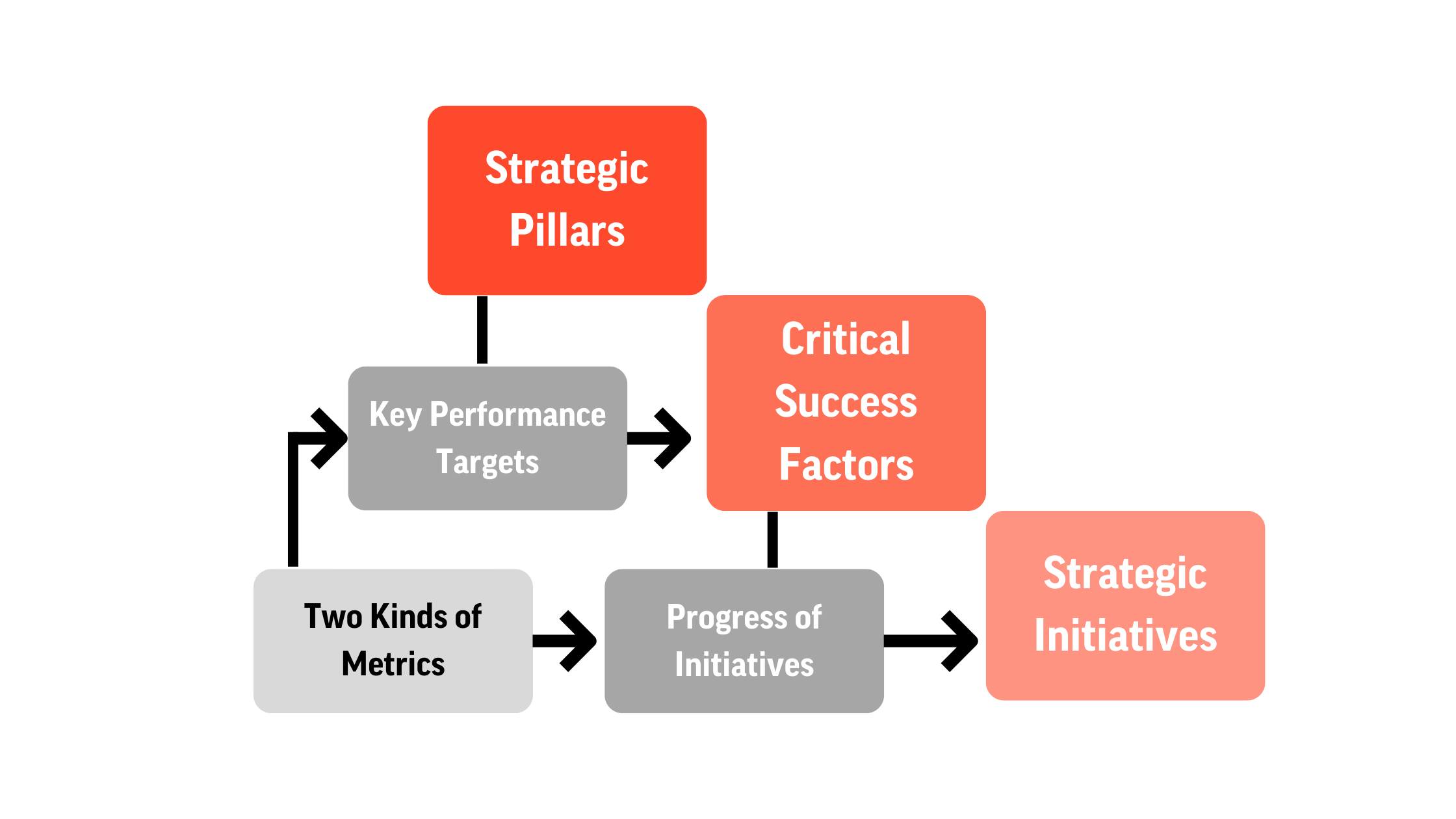Strategy Meetings: Planning vs. Execution

Planning, governance, and follow-up are key to ensuring the effective and successful implementation and execution of strategy and a well-designed meeting structure is essential to maintain the momentum to achieve goals. At DecideAct, we distinguish between planning and execution strategy meetings. Planning meetings are to develop the strategy and ensure that all decision-makers are involved. Execution meetings help establish a powerful infrastructure around your goals by involving the entire organization in implementation and follow-up. The combination results in top-down governance and bottom-up engagement.
These are the different types of Strategy Meetings:
1. PLANNING MEETINGS
The Strategy Development Meeting(s)
This is where leadership crafts the vision and the broad outlines of a strategy to reach it. We always say that you should have a strategy meeting for your strategy—solid groundwork provides a sound decision-making basis for creating and implementing your strategy.
A digital-ready strategy is based on the hierarchical framework most appropriate for your organization (e.g., Pillars, CSFs, KPIs, and Initiatives). An execution-ready strategy also includes a strong and engaging narrative about the journey the organization will take to reach the desired state. 
- Strategy Development Meeting Topics:
- Market/competition analysis
- PESTEL analysis
- Long-term strategic goals and KPIs
- Strategy time period (1, 3 or 5 years?)
- What should we achieve in that period?
- Choose a strategic framework
- How will we measure our performance (KPIs)?
- Define Pillars and Critical Factors
- What will it take for the strategy to succeed?
- Who is responsible for what?
- Governance/follow-up structure
Attendees:

The Kick-off Strategy Meeting
Once you have an execution-ready strategy with a strong narrative, it's time to involve the entire organization to make the strategic objectives a reality. The Kickoff Meeting should be carefully crafted and information-rich. It should not be just a pep talk! A pep talk is only good till the weekend. Show each team where and how it will contribute to the new goal. Team members’ days won’t be just business as usual but contribute to a stronger future. All Strategic Execution Management platforms take daily tasks into account when assigning responsibilities and deadlines; be sure to communicate this. There will be considerably less enthusiasm around projects perceived as adding to everyone’s workload. Be sure all department managers are on board, to keep your organizational culture strong at every level, every day.
- Kickoff Strategy Meeting Topics:
- What the new strategy is about
- Why we need to move from A to B
- What management expects from employees
- What will happen next
Attendees:

Strategic Planning Session 1
Next, the affected org units (both managers and team members) meet to define their must-win battles. Departmental objectives are presented and refined. Accountable persons and their sponsors are identified for each initiative and deadlines are set. The planning meeting also helps ensure alignment between people whose tasks are dependent on each other's deliverables. You’ll typically work with initiatives in quarterly rolls, so the initiative is created at the beginning of the quarter and is due at the end.
There should always be only one person ultimately responsible for any initiative; joint accountability often ends in none at all. This doesn’t mean that only one person carries out the initiative—it may be several—but only one is conclusively responsible. For the same reason, there should only be one sponsor per initiative.
- Strategic Planning Session 1 Topics:
- Define expectations for contributions to the strategy
- Define initiatives
- Set start and end dates
- Identify dependencies (if any)
- Identify Accountable and Sponsor
Attendees:

Strategic Planning Session 2
Once plans and expectations are clear for all involved, a second planning session brings it all together. Here, initiatives are qualified against the overall objective, resource allocation is discussed, and tasks are prioritized.
- Strategic Planning Session 2 Topics:
- Present strategic initiatives and KPIs
- Feedback and comments
- Adjustments if needed
- Final approval of the strategy
Attendees:

You’ve laid a solid foundation for strategy execution. Now keep that momentum going and avoid the fate of most strategies: 75% fail in the implementation stage. Tasks for the greater vision just fall between the cracks of day-to-day running the business.
2. EXECUTION MEETINGS
Strategic Follow-up Meeting
This is where stakeholders can update each other on their progress and discuss any unexpected challenges they may have encountered. Usually held at the departmental or team level, they’re brief meetings focused on the delivery of the strategic tasks. Everyone should leave the meeting knowing exactly what must be achieved before the next strategy meeting in two weeks.
A 21st century Strategy Execution Management platform tracks all tasks, dependencies, and follow-ups—but it’s missing one crucial element: personal contact between team members. Or even video contact. These bimonthly meetings, with their built-in structure (all SEM data is at your fingertips), are productive. Our research shows that these strategy meetings make a measurable difference in strategy execution effectiveness.
- Strategic Follow-up Meeting Topics:
- Are tasks being executed as planned?
- If not, what is needed to deliver?
- Make adjustments and reprioritize as needed
- What has been delivered?
- What is in progress?
- Agree on what to finish before the next meeting
Attendees:

Strategic Review Meeting
Usually held quarterly or bi-annually to be sure the overall direction is still on track. Incomplete initiatives are reassessed, and possible new ones are proposed.
- Strategic Review Meeting Topics:
- Overall status of the strategy
- Challenges
- Is the organization delivering as planned on what was promised?
- If not, what is needed to deliver as promised?
- Decide whether to change priorities or stick to the plan
- Make adjustments and reprioritize as needed
Attendees:

Annual Status Strategy Meeting
Starts with the agenda of a quarterly strategic review meeting, but further evaluates achievements and shortfalls of the previous year. Pillars and Critical Success Factors may be re-evaluated. Essentially, the strategic Big Picture is addressed.
- Annual Status Meeting Topics:
- Overall status of the strategy
- Challenges
- Is the organization delivering as planned on what was promised?
- If not, what is needed to deliver as promised?
- Decide whether to change priorities or stick to the plan
- Make adjustments and reprioritize as needed
Attendees:

Get more impact out of strategy meetings with DecideAct
DecideAct's Strategic Execution Management platform can be the solution to unproductive and frustrating meetings. Everything you need is right on your screen to keep everyone focused on the data. Accountability and accomplishments are unquestionable. The DecideAct system monitors your strategy, follows up, delivers progress reports, and identifies bottlenecks before they even happen. Your team is then freed up to create a better organization for everyone concerned, every day.
By Line Bech Frederiksen, Head of Customer Success at DecideAct










